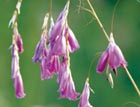Summer flowers: Lupins
Late summer means the fading of favourites, says Roddy Llewellyn


August 11, 2006
My glorious lupins, those indispensably showy stars of June and July, have been dead-headed, as well as the foxgloves planted in among them, so that neither lose any energy through seed production.However, to encourage the foxgloves to spread, I do sometimes leave one or two seed capsules on the base of the spike, as it is they that contain the strongest seed.
It is hard to object to lupins of any colour, and they take on a different dimension if juxtaposed particularly with white foxgloves.In their absence, I might easily have been left bereft of colour in that particular spot had it not been for the wonderful hardy geranium Anne Folkard, which now clambers over the framework of stalks left behind.
I was first made aware of this particularly exciting and vigorous cranesbill in the gardens of Parham House in West Sussex. It had been planted among a group of mature, purple-leaved cotinus where it had attained a height of perhaps 8ft, using the cotinus for support as it climbed up towards the light. I shall never forget the sight of the sun shining through those purple cotinus leaves splashed with Anne Folkard's magenta flowers and yellow-blushed foliage.July witnessed the arrival of the flowers of another beautiful plant, the angel's fishing rod-Dierama pulcherrimum. Graceful sprays of pink bells that are borne at the end of the slenderest stems dance in any gentle breeze.
I have, of course, given this plant pride of place, in a gap in the paving of my terrace where it can be studied at close quarters from the comfort of a seat. Dierama hails from south and east Africa, especially the Natal region of the former, where its preferred habitat is damp grassland, sometimes scree.
It is for this reason that I keep it well watered, starting in May, as it gathers strength for its great display. Another plant that never fails to amaze me is Cerinthe major Purpurascens. I love it because it loves me. It is quite low-growing and excels in very dry, rather poor soil at the base of one of the stone walls of the house that faces south. True, it is beginning to look a little tired by this time of the year, but so would I if I had worked so hard for my living. A prolific self-seeder, its seedlings germinate in the autumn, when they can be thinned.
They continue to grow throughout the winter; even during last winter, a time when they were often exposed to very cold winds. By April, the glaucous blue leaves are joined in perfect harmony by purple flowers that continue to delight us until the beginning of July. It can be removed in its entirety if deemed too ugly at this stage, in the safe know-ledge that the ground beneath the plant will be, if anything, over-seeded. Now is the time to collect and sprinkle those seeds in a hot, sunny spot that is too dry for other plants.There are three special deciduous shrubs that you should know about, which I grow as specimens in a spot protected from fierce winds.
Sign up for the Country Life Newsletter
Exquisite houses, the beauty of Nature, and how to get the most from your life, straight to your inbox.
You will need to delve into your pocket rather deeply for Aralia elata Aureovariegata (its expense being because it is so difficult to propagate). David Hicks always used to say that the reason for his disliking variegated plants was because they were 'undecided'.
I think he has a point, but when it comes to this particular shrub, any such thoughts vanish. Its huge, pinnate leaves, splashed with yellow, can attain a length of 4ft. It is less vigorous than the plain green species (often the case) that grows into a delightful small tree.The variety of stag's horn sumach with feathery leaves, Rhus typhina Dissecta, is another thing of beauty. It is less likely to sucker than the ubiquitous common sumach, and its finely dissected leaves turn to colours so brilliant in the autumn that they look as if someone is holding a bright torch behind each one.
My other pride and joy is Elaeagnus angustifolia Quicksilver, which can eventually take up a fair amount of space, being about 12ft tall and wide. Best suited close to a sunny wall or fence, its small silver leaves, borne in profusion, become a glimmering focal point in the garden.
This article first appeared in COUNTRY LIFE magazine on July 27, 2006
Country Life is unlike any other magazine: the only glossy weekly on the newsstand and the only magazine that has been guest-edited by HRH The King not once, but twice. It is a celebration of modern rural life and all its diverse joys and pleasures — that was first published in Queen Victoria's Diamond Jubilee year. Our eclectic mixture of witty and informative content — from the most up-to-date property news and commentary and a coveted glimpse inside some of the UK's best houses and gardens, to gardening, the arts and interior design, written by experts in their field — still cannot be found in print or online, anywhere else.
-
 380 acres and 90 bedrooms on the £25m private island being sold by one of Britain's top music producers
380 acres and 90 bedrooms on the £25m private island being sold by one of Britain's top music producersStormzy, Rihanna and the Rolling Stones are just a part of the story at Osea Island, a dot on the map in the seas off Essex.
By Lotte Brundle
-
 'A delicious chance to step back in time and bask in the best of Britain': An insider's guide to The Season
'A delicious chance to step back in time and bask in the best of Britain': An insider's guide to The SeasonHere's how to navigate this summer's top events in style, from those who know best.
By Madeleine Silver